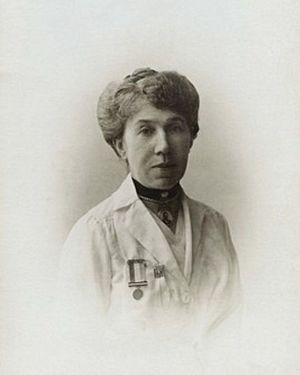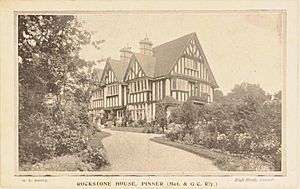Janie Terrero facts for kids

Janie Terrero (born April 14, 1858 – died June 22, 1944) was a brave suffragette who fought for women's right to vote. She was a member of the Women's Social and Political Union (WSPU). Because of her activism, she was sent to prison and even force-fed. For her courage, she received the WSPU's special Hunger Strike Medal.
Contents
Early Life and Family
Janie Terrero was born as Jane Beddall in Finchingfield, Essex, in 1858. She was the youngest daughter of Eliza and Thomas Beddall, who was a farmer. She grew up in a comfortable middle-class home.
In December 1885, she married Máximo Manuel Juan Nepomuceno Terrero y Ortiz de Rosas, known as Manuel Terrero. His family had important connections in Argentina. Janie and Manuel lived in Southampton for many years before moving to a house called 'Rockstone House' in Pinner, Middlesex, which was built just for them.
Fighting for Women's Rights

Janie Terrero believed in women's right to vote from a young age. When she was 18, she became a suffragist. In 1908, she joined the Women's Social and Political Union (WSPU), a group known for its strong actions to get women the vote. She was also part of the National Union of Women's Suffrage Societies (NUWSS), another group working for the same goal.
In 1910, Janie started a local WSPU group in Pinner and became its secretary. She and her husband often held parties at their home, 'Rockstone House', to support the WSPU. Famous suffragettes, like Lady Constance Bulwer-Lytton, even spoke at their events. Like many suffragettes, Janie avoided the 1911 Census. This was a form of protest against a government that didn't let women vote.
Protest and Imprisonment
In March 1912, Janie was one of about 200 women arrested during a protest in London. They broke windows to draw attention to their cause, especially as a new bill about voting rights was being discussed in Parliament. Janie's husband, Manuel, supported her actions. He was even a member of the Men's League for Women's Suffrage.
Janie wrote to her husband before the protest, saying she had to take a stand. She told him not to pay her fine if she was arrested, but to let her "go through it properly." On March 2, 1912, she appeared in court for breaking windows. She was found guilty and sentenced to four months in Holloway Prison.
Hunger Strike and Force-Feeding
While in Holloway Prison, Janie Terrero went on a hunger strike. This meant she refused to eat as a protest. Because of this, she was force-fed twice. This was a very harsh method where food was forced into prisoners to stop them from starving. A prison doctor eventually stopped her force-feeding, likely because of her health. She was released a few days before her sentence ended.
Janie's signature is on The Suffragette Handkerchief, a special cloth embroidered by suffragettes in Holloway Prison in March 1912.
She later wrote about her time in prison, saying:
- "You cannot imagine how strong you feel in prison."
- She believed the government feared hunger strikes because they hurt their image.
- She felt that women had just as much physical courage as men.
- She clearly stated that force-feeding was meant to be a cruel act, not to save lives.
After 1912, Janie Terrero seemed to take less part in the fight for women's right to vote.
Legacy and Later Life
Janie Terrero passed away in her home in 1944 at the age of 86. She and her husband Manuel are buried in the Anglican section of Southampton Old Cemetery.
Janie left behind detailed notes about her treatment in Holloway Prison. These important papers are now kept in the Suffragette Fellowship Collection at the Museum of London. She also gave 2,000 books to the library of the Working Men's College from her husband's will.
The Museum of London also has a beautiful tapestry that Janie Terrero embroidered while in Holloway Prison. It is decorated in the suffragette colors of purple, white, and green. The tapestry includes the names of other hunger strikers who were imprisoned with her in March 1912 for their part in the window-smashing campaign.
Images for kids
-
Janie Terrero wearing her Hunger Strike Medal and Holloway brooch around 1912
-
'Rockstone House' in Pinner was built for the Terreros and became a key place for WSPU activities.
See also
 In Spanish: Janie Terrero para niños
In Spanish: Janie Terrero para niños



